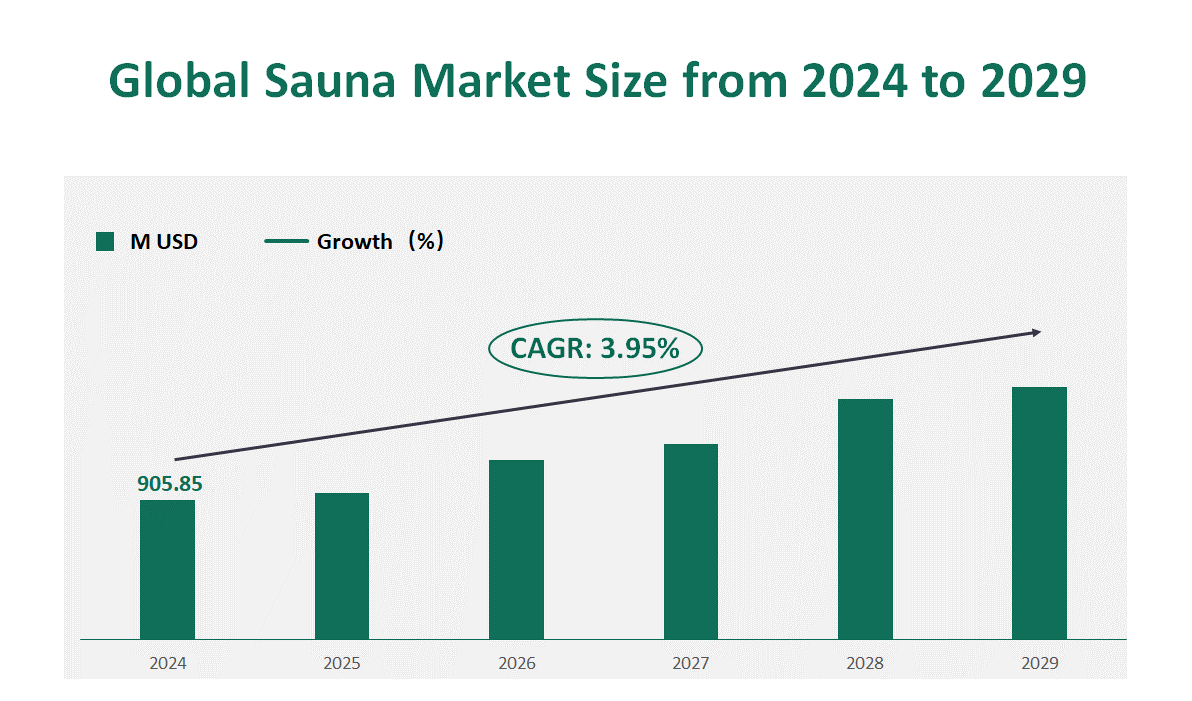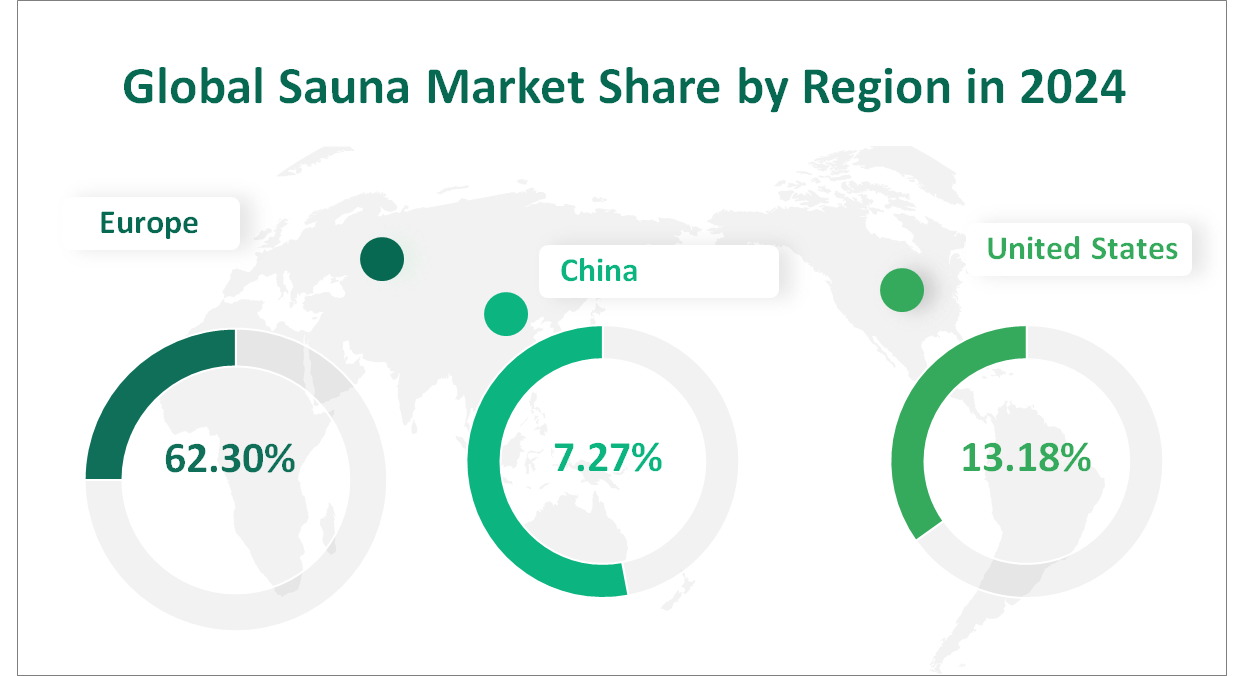1 Global Sauna Market Size (Revenue) and CAGR (2024-2029)
The global sauna market is projected to reach a value of USD 905.85 million in 2024, reflecting a Compound Annual Growth Rate (CAGR) of 3.95% from 2024 to 2030.
Sauna refers to the process of treating the human body with steam or dry heat in a closed room, making people sweat a lot. A thermometer is usually used to measure heat and a hygrometer to measure humidity in order to maintain the optimal physiotherapy condition in the sauna. A sauna, a fixture in many cultures for relaxation and health benefits, is a room designed as a space for heat therapy, traditionally featuring dry or wet heat. The market’s growth is attributed to the increasing awareness of the health benefits of sauna use, including improved cardiovascular health, relaxation, and stress relief.
With the development of The Times, new sauna facilities continue to emerge, from the experience, size, technology and other aspects of development. With the development of technology and the upgrading of demand, sauna cabins tend to be intensive and compact. In terms of function, sauna facilities tend to develop intelligently, such as using apps for remote supervision and control of sauna facilities. In terms of experience, sauna facilities tend to be more comfortable, and the progress of heating elements is a strong support to promote the strengthening of the experience of sauna facilities.
In the past ten years, the heating elements of the sauna have made great progress. Manufacturers have developed more efficient and uniform heating systems that not only generate more heat, consume less energy, operate more economically and safely, but also provide a more comfortable and effective sauna experience.
In addition, in terms of materials, manufacturers are working to enhance the overall user experience by improving comfort features, such as heat-treated wood, personalized tiles, etc., improving the durability, aesthetics, and performance of facilities and products. In conclusion, the sauna industry is constantly evolving and incorporating the latest technological advancements to improve the user experience, promote health and wellness benefits, and enhance the overall performance and efficiency of facilities and products.
Figure Global Sauna Market Size (M USD) Outlook (2024-2029)

2 Sauna Industry Drivers, Opportunities and Market Challenges
Table Key Market Drivers and Opportunities of Sauna
|
Descriptions | |
|
Good for one’s health |
Saunas can relax the body and mind and have many health benefits including sleep, mental health, possible pain relief, weight loss and improved immune system. According to the NIH research review, frequent dry sauna bathing can improve a variety of subjective and objective health parameters, such as lower overall mortality and lower rates of cardiovascular events and dementia. The clearest clinical benefits of sauna bathing relate to cardiovascular disease, and Finnish or infrared saunas may be beneficial for patients with rheumatic diseases such as fibromyalgia, rheumatoid arthritis and ankylosing spondylitis, patients with chronic fatigue and pain syndrome, chronic obstructive pulmonary disease and allergic rhinitis. Saunas can also improve athletic performance, skin moisture resistance and quality of life without causing serious adverse events. (source: Clinical Effects of Regular Dry Sauna Bathing: A Systematic Review). It is precisely due to the positive impact of saunas on physical health that is the main driving force for the growth of this market. |
|
Growing consumer demand |
Sauna is a form of whole body heat therapy, popular in many countries and regions, has a long history, contains internal spiritual culture, such as Finnish sauna, Turkish bath, Russian sauna, Korean sauna and so on. Therefore, sauna is a well-known means of leisure and relaxation, with a huge consumer demand market. Saunas are also popular in homes, public centers, leisure clubs, etc. In addition, with the deepening of the aging process of society and the increasing prevalence of chronic diseases, people’s interest in sauna therapy continues to deepen. And some clinical studies have confirmed that sauna therapy is beneficial to human health, and dry sauna can improve a variety of subjective and objective health parameters. Therefore, the improvement of people’s health awareness is the main driving factor to promote sauna as a traditional way of health care is favored by more and more people, and also provides a broad market space for the development of sauna industry. |
Table Market Challenges of Sauna
|
Item |
Descriptions |
|
The price threshold of the product is high |
Europe and the United States as the largest consumer market of sauna, there is still a huge consumption potential, but due to the high price threshold, far from reaching a huge market potential. Even when products produced by Chinese manufacturers are exported to the US market, prices are still relatively high. In addition, the per capita income of consumers in developing regions is low, and most people have less spending power. Because the consumption concept in many developing regions has not changed, the consumer demand for some sauna equipment has not been fully released, and the supply of products is limited. In addition, the product production technology is not mature enough, resulting in higher product costs. To some extent, it limits the market expansion of this product. The high price will make the promotion of sauna products in these areas more difficult. |
|
Potential security risks |
Saunas are a safe form of recreation for most people, but they are not suitable for everyone. People with heart disease, epilepsy, high blood pressure, diabetes and other diseases should not use saunas because it may cause serious risks such as heart failure. Children and the elderly are particularly susceptible. In addition, prolonged sauna use may lead to loss of electrolytes, and overheating may cause dehydration or even stroke, so it is necessary to replenish water regularly. Drinking alcohol in a sauna significantly increases safety risks, and prolonged sauna use may also lead to shock, burns, or even death. It is not advisable to drink cold drinks or soak in cold water immediately after sauna, because the large temperature difference will stimulate the sympathetic nervous system, causing high blood pressure and increasing the risk of heart attack. Therefore, the potential safety risks of saunas may limit the development of this industry. |
3 Global Sauna Sales Market Share by Type in 2024
The main types of sauna industry can be divided into infrared sauna and traditional sauna, among which traditional sauna occupied the main market share of 64.40% in 2024. The market share of infrared sauna in 2024 was 35.60%.
An infrared sauna is a type of sauna that uses infrared heating technology. It heats the body directly by emitting infrared radiation, rather than heating the air, which can provide a more comfortable experience and is suitable for long-term use. Traditional saunas heat the air to raise the indoor temperature, usually using wood, gas or electric heaters, which are higher in temperature and produce steam and heat that can promote sweating and relaxation. The main difference between the two is the heating method. Infrared saunas focus more on directly heating the body and providing a gentle thermal effect, while traditional saunas emphasize the combination of high temperature and steam to create a more classic sauna experience.
Table Global Sauna Market Share Forecast by Types in 2024
|
|
2024 |
|
Infrared Sauna |
35.60% |
|
Traditional Sauna |
64.40% |
|
Total |
100.00% |
4 Global Sauna Sales Market Share by Application in 2024
In the market share of different applications in the global sauna market in 2024, residential applications dominate with a market share of 69.69%, followed by commercial applications with a market share of 30.31%.
Residential is the main part of the sauna market, accounting for 69.69% of the market share in 2024. With the accelerated pace of modern life and the improvement of people’s health awareness, more and more families tend to install sauna facilities at home so that they can enjoy the relaxation and health benefits brought by sauna at any time. Home sauna not only provides a private and comfortable environment, but also meets the needs of individuals or families to relieve stress, improve blood circulation and improve overall health. Therefore, the demand for residential sauna continues to grow worldwide, especially in developed countries, and occupies a major share of the market.
The market share of Commercial applications is expected to be 30.31%. Although home applications account for the largest market share, the demand for saunas in the commercial sector cannot be ignored. Saunas are mainly used in spas, gyms, hotels, and resorts, providing customers with a space to relax and rejuvenate, attracting a large number of consumers who pursue a healthy and comfortable experience. As people pay more attention to a healthy lifestyle, saunas not only enhance the overall experience of customers, but also become an important selling point for many high-end service venues. In addition, saunas are used more frequently and can bring considerable profits to operators, so they occupy an important position in the market.
Table Global Sauna Market Share by Application in 2024
|
2024 | |
|
Residential |
69.69% |
|
Commercial |
30.31% |
|
Total |
100.00% |
5 Global Sauna Sales Market Share by Region in 2024
The performance of the global sauna market in 2024 varies in different regions. Europe is the largest regional market in the global sauna market with a market share of 62.08%. The second largest market share is the United States, with a share of 13.18% in 2024. In addition, China and Japan also occupy important markets, with market shares of 7.27% and 2.99% respectively in 2024.
Regional economic conditions, including GDP growth rate and consumer purchasing power, will affect the demand for sauna products and facilities. For example, sauna is a household consumer product under the background of traditional European and American culture, and it is also an emerging fashion product under modern living conditions. Therefore, Europe and the United States are the main regions leading the sauna industry. Japan, South America, the Middle East and other Asia-Pacific regions are important potential markets for the far-infrared sauna industry. In these markets, economic development is relatively stable, and many developing regions are facing development opportunities of “consumption upgrading”. In addition, in these developing and developed countries, the health industry has become a powerful driving force for the growth of the entire national economy, providing a broad potential market for the sauna industry.
Figure Global Sauna Market Share by Region in 2024

6 Global Sauna Major Players in 2024
The top three companies in the global sauna market include Harvia, KLAFS, and SAUNAKING. These companies are recognized for their innovation in sauna technology, wide product ranges, and significant market shares. For instance, Harvia, a Finnish company, is known for its comprehensive sauna solutions, while KLAFS, a German brand, specializes in luxury saunas and wellness products.
Harvia is a global leader in the sauna and spa market. Harvia has a comprehensive sauna and spa product range, from heaters and their components to full sauna and spa solutions – meeting the needs of consumers and industry professionals alike.
Harvia is a global leader in the sauna and spa market. Harvia has a comprehensive sauna and spa product range, from heaters and their components to full sauna and spa solutions – meeting the needs of consumers and industry professionals alike.
Anhui Saunaking Co., Ltd. Established in 1995, we are the leader of professional manufacturer and exporter of Infrared Cabin, Portable Steam Sauna, and Traditional Finnish Sauna equipment in the local profession community. Their company has professional research and development capability, strict quality management, sincere After-Sale service.
Table Global Sauna Headquarters by Major Players





